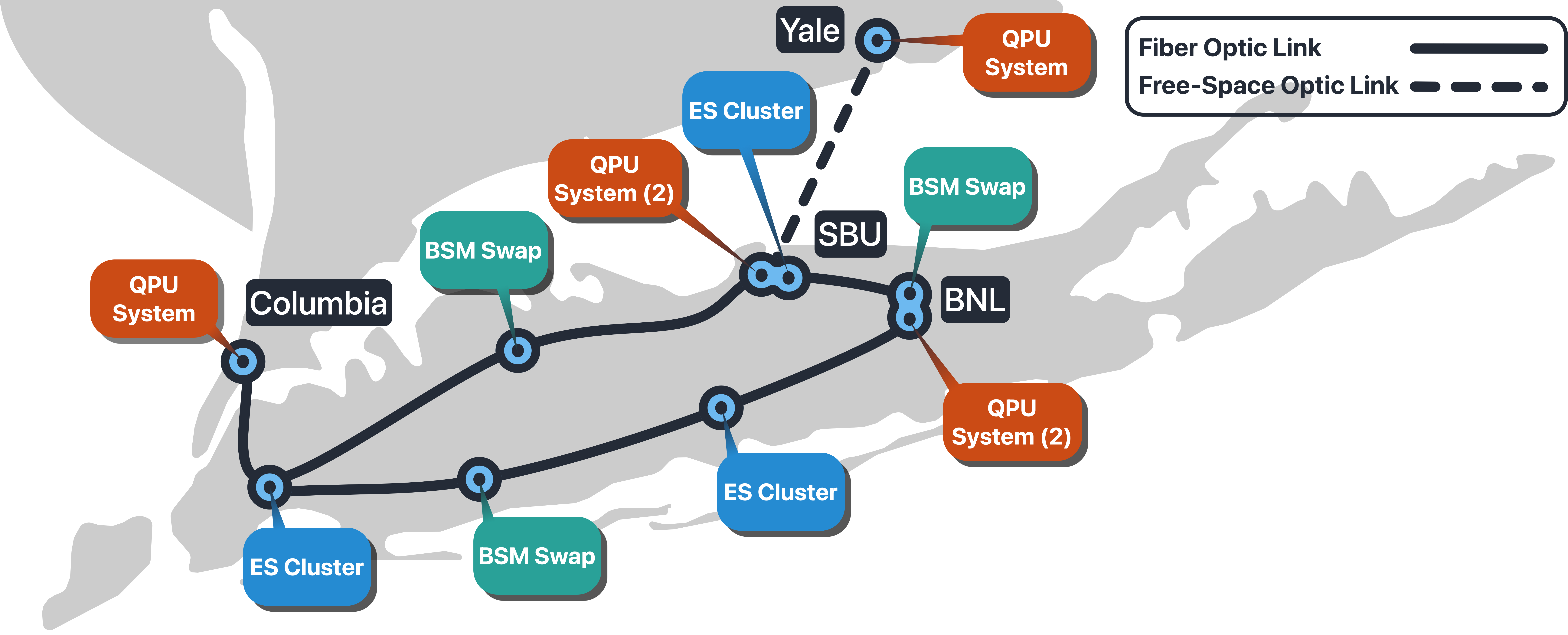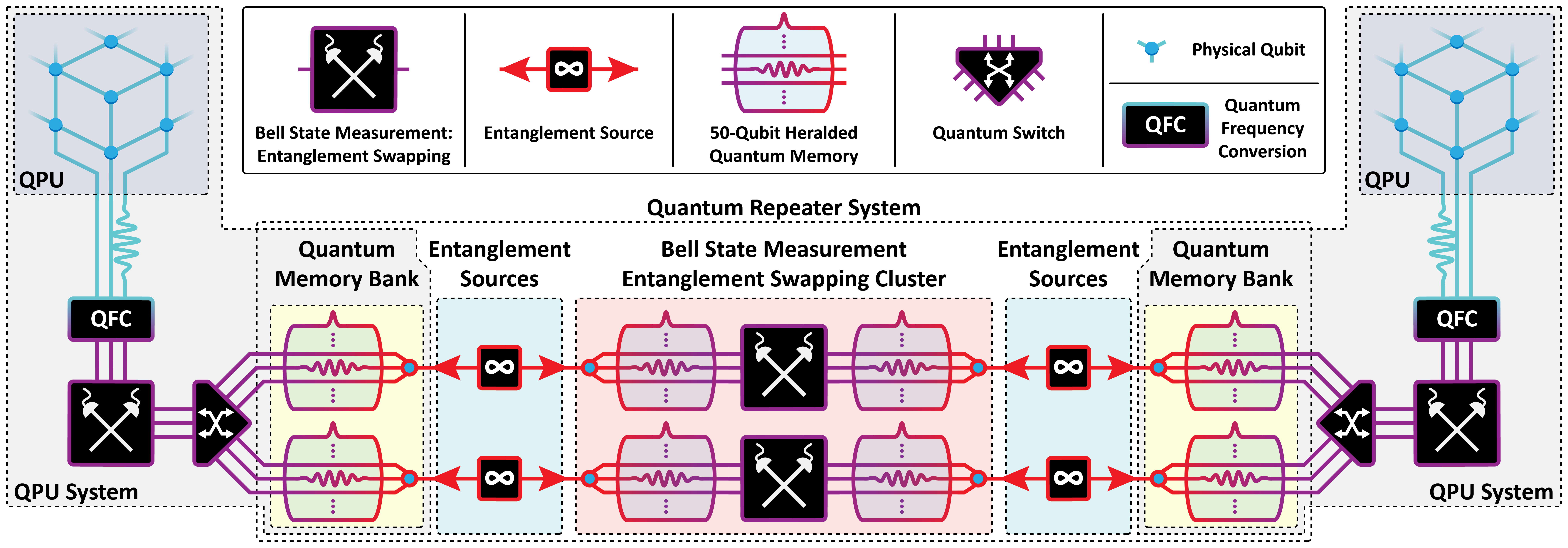SCY-QNet
The National Quantum Virtual Laboratory (NQVL) program, created by the National Science Foundation (NSF) is one of the NSF's most competitive programs launched within the Quantum Information Science and Technology (QIST) sector. This program is designed to be “a systematic approach to maturing quantum technology platforms by integrating end-users from other fields of science and engineering and other sectors of the economy.” Through three competitive phases of development, the NQVL program is expected to yield several large projects that will significantly advance QIST and profoundly impact the scientific landscape of the region, and serve as the cornerstone of quantum technology development in the United States for the next decade.
The NSF NQVL QSTD: Pilot Phase “SCY-QNet: A Wide-Area Quantum Network To Demonstrate Quantum Advantage” is led by Stony Brook University, in collaboration with Columbia University, Yale University and the Brookhaven National Laboratory. Announced in August 2024, it is one of five NQVL pilot programs in the US and is aligned with the 2018 National Quantum Initiative Act under NSF 23-604.
Our project, entitled: "SCY-QNet: A Wide-Area Quantum Network To Demonstrate Quantum Advantage," aims to design and implement a 10-node quantum network connecting state-of-the-art laboratories at Stony Brook University, Brookhaven National Laboratory, Columbia University, and Yale University, creating the Stony Brook–Columbia–Yale Quantum Network (SCY-QNet). It will be the first version of a wide-area quantum Internet network, addressing a significant need in the field of QIST and drawing interest from researchers and the public alike.

Figure 1. The envisioned SCY-QNet facility across Stony Brook, Columbia, Yale, and Brookhaven. The end nodes will have atomic-based Quantum Processing Units (QPUs) and Quantum Frequency Converters (QFCs). The intermediate nodes will deploy Entanglement Sources (ESs), Quantum Memory Banks (QMBs), and Entanglement Swapping Stations, to facilitate the generation of long-distance entanglement via quantum repeaters. [Design courtesy of L. Castillo-Veneros, Stony Brook University.]
SCY-QNet is meant to demonstrate quantum advantage in meaningful applications, enhancing current information systems, such as long-distance hackproof encryption and data communication via teleportation. It can also be an instrument to gain insights into unknown physical phenomena that require entangled systems to be understood.
The project is envisioned as an advanced long-distance quantum network connecting quantum processing units across all the participant institutions via quantum entanglement using quantum repeaters. “This project has the potential to boost the scaling of quantum computing systems via quantum networks, forming a first version of the Quantum Internet.
Bringing quantum information and entanglement across several nodes and over long distances will provide the foundation for researchers to develop more secure networks, precise measurement systems, and powerful algorithms. We plan to make SCY-QNet available to many institutions across the country, and the team is excited to develop these ideas into a national facility, providing access to cutting-edge quantum network technology to a large community of users.
For the larger New York metro area, including Connecticut, the SCY-QNet project is an excellent opportunity to expand the region’s leadership in QIST by operating a large quantum national facility.
It is expected that developing SCY-QNet will attract top talent to the region, which is essential to design and run all the facility components, including the science, engineering, and computer science needs. Developing the facility will be invaluable for developing a quantum-trained workforce at a scale never attempted before.

Figure 2 The key components of SCY-QNet architecture include: (i) Heralded quantum memories with sufficient storage times and retrieval efficiency to generate remote entanglement with high rates, (ii) Quantum repeater systems, including high-rate entanglement sources and efficient entanglement-swapping devices, (iii) Quantum Processing Units (QPUs) with atom-based qubits that facilitate high entanglement rates with atom-based memories, (iv) Quantum Frequency Conversion (QFC) units to bridge the frequency gap between quantum memories and QPUs, and (v) Quantum network communication infrastructure,, including fiber-based and free-space optical links and a network stack (not shown) with software-defined control modules. [Design courtesy of C. Wallace, Stony Brook University.]
The development of SCY-QNet has the potential, in conjunction with a broader program, to expand its technical capabilities toward reaching more institutions in NYS, including more SUNY campuses and the Air Force Research Laboratory. If selected for phases II and III, SCY-QNet will parallel the development of the classical Internet by constructing interconnected local area quantum networks across different urban areas in the larger NY metro area and could become the first region-wide quantum internet prototype, constituting the blueprint for a US-wide Quantum Internet.
To learn more about the SCY-QNet laboratories and teams:
- Prof. Eden Figueroa, Quantum Internet Group. Figueroa Research Group | Stony Brook University
- Prof. Himanshu Gupta, Quantum Networking and Computing Laboratory
- Prof. Sebastian Will, Ultra-Cold Atomic System Laboratory: Home | will-lab
- Prof. Hong Tang, Quantum Technology and Nanodevices Laboratory: Yale Nanodevices laboratory
- Prof. Michal Lipson, Nanophotonics Laboratory: Michal Lipson | Lipson Nanophotonics Group
- Prof. Domink Schneble, Ultracold Atomic Systems Laboratory: Prof. Dominik Schneble - Ultracold Quantum Systems - Stony Brook University
- Prof. Alexander Gaeta, Quantum and Nonlinear Photonics Laboratory: Alexander L. Gaeta | Columbia University | Gaeta Group | Quantum and Nonlinear Photonics Group
- BNL Quantum Network Facility: BNL | Quantum Network Facility
